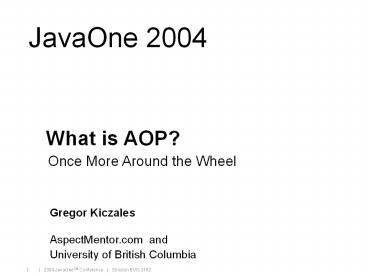What is AOP? - PowerPoint PPT Presentation
Title:
What is AOP?
Description:
In 1969 most programmers would have used. this has poor design and code modularity! ... over hype, bad pedagogy. each new wave of adoption brings new zealots / critics ... – PowerPoint PPT presentation
Number of Views:80
Avg rating:3.0/5.0
Title: What is AOP?
1
What is AOP?
Once More Around the Wheel
- Gregor Kiczales
- AspectMentor.com and
- University of British Columbia
2
- Consider developinga simple drawing application
(JHotDraw)
3
objects are intuitive
- Intuitively thinking of objects?
- Points, Lines
- Drawing surfaces
- GUI Widgets
4
objects are not intuitive
objects are intuitive
- In 1969 most programmers would have used
- this has poor design and code modularity!
2 4
22 12
65 93
43 29
86 65
6 7 5 8
5
not intuitive
- OOP invented in 1961
- about same time as structured programming
- term object-oriented programming in 1967
- to make simulation code look like the model
6
- What is OOP?
- a way of thinking
- objects, classification hierarchies
- supporting mechanisms
- classes, encapsulation, polymorphism
- allows us to
- make code look like the design
- improves design and code modularity
- many possible implementations
- style, library, ad-hoc PL extension, integrated
in PL
many other benefits build on these
7
OOP
MVC
Observer Pattern
fair design modularitybut poor code modularity
8
OOP
MVC
Observer Pattern
- Meanwhile back at the ranch
- starting in early 80s (perhaps earlier)
- others began work on
- crosscutting structure
- mechanisms
- behavioral reflection, metaobject
protocols,subject-oriented programming - aspect-oriented programming term in 1997
9
aspect ObserverPattern private Display
Shape.display pointcut change()
call(void figures.Point.setX(int))
call(void Point.setY(int)) call(void
Line.setP1(Point)) call(void
Line.setP2(Point)) call(void
Shape.moveBy(int, int)) after(Shape s)
returning change()
target(s) s.display.refresh()
1
ObserverPattern
10
aspect ObserverPattern private Display
Shape.display pointcut change()
call(void Shape.moveBy(int, int))
call(void Shape.set(..)) after(Shape s)
returning change()
target(s) s.display.refresh()
1
ObserverPattern
well-definedcrosscutting structure
11
Ask yourselfcould you name asingle class
ObserverPattern ?
aspect ObserverPattern private Display
Shape.display pointcut change()
call(void Shape.moveBy(int, int))
call(void Shape.set(..)) after(Shape s)
returning change()
target(s) s.display.refresh()
1
ObserverPattern
well-definedcrosscutting structure
12
- What is AOP?
- a way of thinking
- aspects, crosscutting structure
- supporting mechanisms
- join points, pointcuts, advice
- allows us to
- make code look like the design
- improve design and code modularity
- many possible implementations
- style, library, ad-hoc PL extension, integrated
in PL
13
- Other Aspects
- design patterns Google AOP design pattern
- Swing thread safety AspectJ in Action
- policy enforcement
- authentication, synchronization, architecture
- transaction management
- debugging support
- logging (of course)
- and many application-specific aspects
14
- IBM reports
- implementation of platform policies
- 15-30 quality improvements
- significant productivity gains
- improvements in modularity of complex software
- new business opportunities
15
- Issues
- good vs. bad uses
- can overuse/misuse any mechanism
- we have learned a lot, we need to learn more
- over hype, bad pedagogy
- each new wave of adoption brings new zealots /
critics - some old lessons need to be rediscovered
- tools
- quality, support
- training, organization structure
- whats the business value?
16
- Issue Proper Style
- mechanisms can be misused
- too many or wrong procedures
- too many or wrong classes
- too much or wrong overriding
- too many or wrong aspects, advice, introductions
- we already know a lot
- 15 rule, well-defined crosscutting, tool support
- we have a lot to learn
- interaction w/ JSR-175 more semantic pointcuts
- scaling
17
- Issue Implementation Quality
- implementations vary gt 10x in performance!
- range of existing strategies
- VM-based implementation just now starting
- limited existing benchmarks
- but this is getting better fast
18
- Issue Over-stated claims, bad pedagogy
- each wave of interest / adoption
- new proponents and critics
- have different priorities
- but must re-learn old lessons
- new generations of proponents
- can be too optimistic
- new generations of teachers
- can miss critical insights
- new generation of critics
- can miss previously discussed issues
19
- Question for panelHow can Java Platform remain
1 for AOP? - what are the next steps?
- how does really new technology get in?
- what are the technical issues?
- how can AOP get proven enough
- what are market issues?
- is AOP disruptive technology for J2EE?
- where does it produce significant value?
- what will Redmond do?




























![AOP and Modular Reasoning [ICSE05] PowerPoint PPT Presentation](https://s3.amazonaws.com/images.powershow.com/P1252109111JGyob.th0.jpg?_=20160211098)


